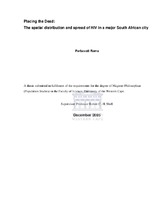| dc.contributor.advisor | Shell, Robert C.H. | |
| dc.contributor.author | Rama, Parbavati | |
| dc.contributor.other | Dept. of Mathematics | |
| dc.contributor.other | Faculty of Science | |
| dc.date.accessioned | 2013-07-19T09:10:14Z | |
| dc.date.available | 2007/04/20 11:28 | |
| dc.date.available | 2007/04/20 | |
| dc.date.available | 2013-07-19T09:10:14Z | |
| dc.date.issued | 2005 | |
| dc.identifier.uri | http://hdl.handle.net/11394/1695 | |
| dc.description | Magister Philosophiae - MPhil | en_US |
| dc.description.abstract | The aim of this study was to establish a new understanding of the epidemiology of HIV/AIDS at the municipal level, but at the same time upholding the anonymity of the HIV infected and AIDS sufferers. Innovative research techniques such as the use of GIS (geographic information systems) as a research tool contributed to disclosing the patterns of the HIV pandemic in the Nelson Mandela Metropole that were not obvious or visible before. GIS involved geographic maps that detect the spatial relationship between HIV prevalence rates and vectors that drive the pandemic. | en_US |
| dc.language.iso | en | en_US |
| dc.publisher | University of the Western Cape | en_US |
| dc.subject | AIDS (Disease) | en_US |
| dc.subject | South Africa | en_US |
| dc.subject | Eastern Cape | en_US |
| dc.subject | HIV (Viruses) | en_US |
| dc.subject | Epidemiology | en_US |
| dc.title | Placing the dead: the spatial distribution and spread of HIV in a major South African city | en_US |
| dc.type | Thesis | en_US |
| dc.rights.holder | University of the Western Cape | en_US |
| dc.description.country | South Africa | |

